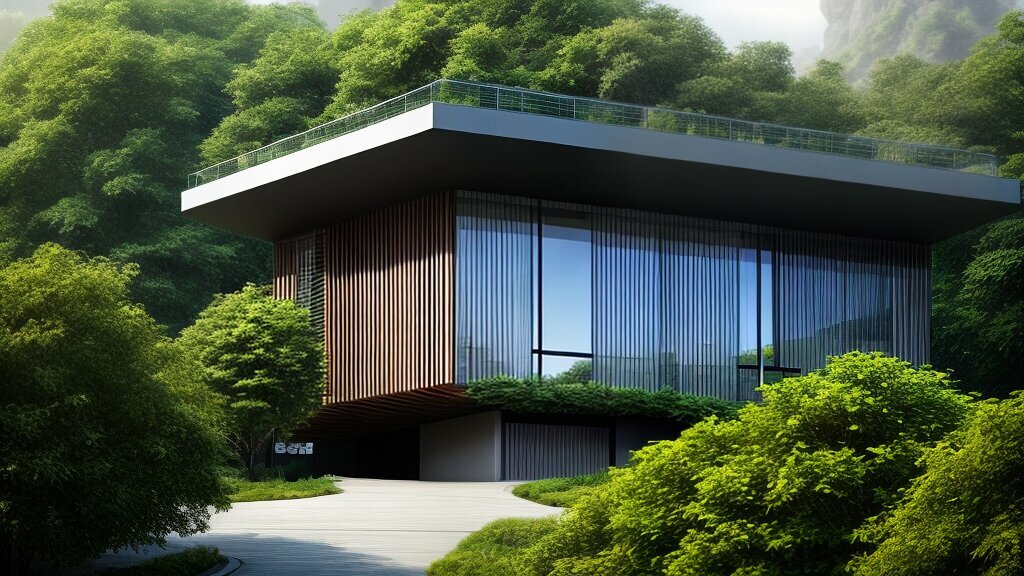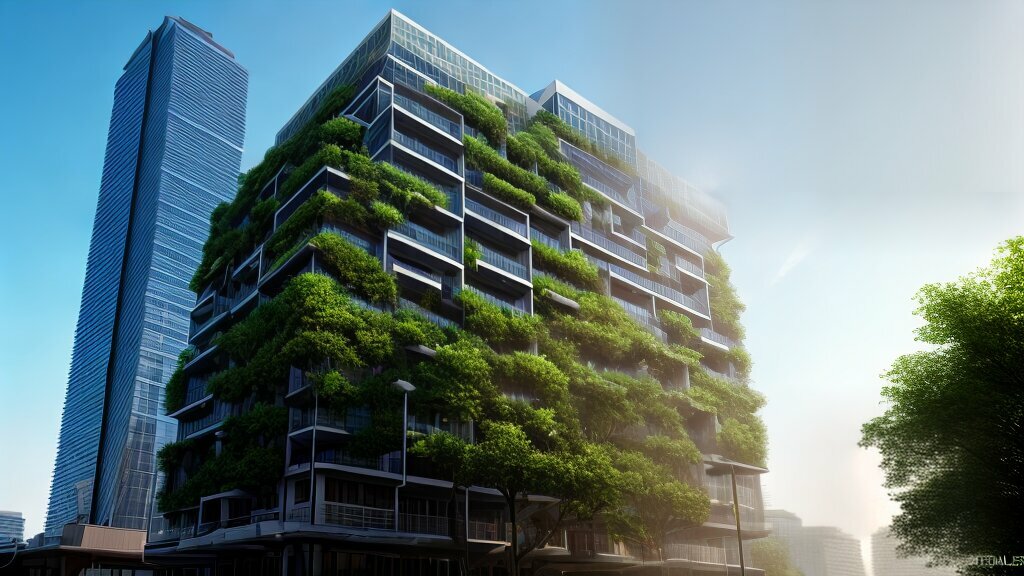Welcome to our article on the economics of sustainable construction. Sustainable construction economics refers to the consideration of financial factors in the decision-making process of sustainable building practices and materials. As our world faces environmental challenges, it’s becoming increasingly essential to adopt sustainable construction practices to mitigate the negative effects of climate change.
In this section, we will explore the long-term cost benefits of sustainable construction economics and its relevance in the field of construction. We’ll also discuss the importance of considering the financial aspect of sustainable development to ensure a more sustainable and prosperous future for all.
Key Takeaways:
- The economics of sustainable construction involves considering financial factors in the decision-making process of sustainable building practices and materials.
- Sustainable construction is becoming increasingly essential in mitigating the negative effects of climate change.
- Considering the financial aspect of sustainable development is crucial to ensuring a sustainable and prosperous future for all.
Understanding Sustainable Construction Economics
Sustainable construction economics is a rapidly growing field that aims to merge sustainable development principles with construction practices. The goal is to create long-term economic, social, and environmental benefits by integrating sustainable practices into all aspects of construction. The concept of sustainable development economics is not new, but the application of economic theories and principles to sustainable construction is still in its infancy.
The construction industry has traditionally focused on short-term economic gains, often neglecting the long-term economic benefits that sustainable construction can offer. Sustainable construction economics aims to shift the focus towards a more balanced approach, where economic benefits are considered alongside environmental and social ones. This approach can lead to significant long-term savings and benefits for all involved.
Key principles of sustainable construction economics
Sustainable construction economics relies on several key principles that are essential for the successful implementation of sustainable practices. These include:
- Life cycle cost analysis – This involves evaluating the costs and benefits of a project over its entire lifetime, from design to demolition. It enables a holistic view of the project, helping to identify areas where sustainable practices can lead to long-term cost savings.
- Energy efficiency – This involves designing buildings and infrastructure that use less energy, reducing operational costs and carbon emissions. Energy-efficient design can also improve the comfort and well-being of occupants.
- Resource conservation – This involves reducing waste and maximizing the use of renewable resources, such as solar and wind power. It can lead to significant cost savings and reduce the environmental impact of the project.
The economic advantages of green building
Green building, a key component of sustainable construction, offers several economic advantages. According to a study by the US Green Building Council, green building practices can result in:
- Lower operational costs – Energy-efficient buildings use less electricity and water, resulting in lower utility bills.
- Higher property values – Green buildings are in high demand and can command higher rents and sale prices.
- Improved occupant productivity and health – Healthy work environments can lead to increased productivity and reduced absenteeism, resulting in higher profits for businesses.
These economic advantages illustrate how sustainable construction economics can benefit both the environment and the bottom line.

“Building green and sustainable is not just a trend, it’s a necessity. It’s the way we should be building now and in the future.”
By understanding sustainable construction economics, stakeholders in the construction industry can make informed decisions that consider the long-term economic, environmental, and social impacts of their projects. The next sections will explore the costs of sustainable construction and the importance of sustainable materials and practices.
The Cost of Sustainable Construction
While sustainable construction practices offer long-term cost benefits, implementing them can require a significant initial investment. It’s important to consider the cost aspect of sustainable development since financial viability is a crucial factor in decision-making. However, the benefits of sustainable construction often outweigh the costs in the long run.
Several factors impact the cost of sustainable construction, including energy efficiency, life cycle analysis, and resource conservation. Energy-efficient design can help reduce operational costs over time, while life cycle analysis considers the environmental impact of materials used throughout the building’s lifespan. Resource conservation strategies, such as using recycled materials and reducing waste, can also impact overall costs.
| Sustainable Construction Costs |
Factors Contributing to Cost |
| Initial Investment |
Implementing sustainable construction practices requires an upfront investment that may be higher than traditional construction methods. |
| Energy Efficiency |
Energy-efficient designs may require additional costs for equipment and materials, but they can result in lower operational costs over time. |
| Life Cycle Analysis |
Materials with a lower environmental impact may cost more initially, but their long-term benefits can outweigh the added expense. |
| Resource Conservation |
Implementing resource conservation strategies, such as using recycled materials, can impact overall costs. |
Despite the initial investment, sustainable construction can offer significant cost savings over the building’s lifespan. For example, using energy-efficient systems can reduce energy consumption and result in lower energy bills. Investing in renewable energy sources, such as solar panels, can also reduce energy costs over time. Additionally, sustainable construction practices can increase the value of a property, making it a more lucrative investment in the long term.

Ultimately, while sustainable construction may require a larger initial investment, its long-term cost benefits, including reduced operational costs and increased property value, make it a financially sound choice in the long run.
Sustainable Construction Materials
Sustainable construction materials play a critical role in promoting the long-term cost benefits of sustainable construction. These materials offer several advantages over traditional construction materials, including lower environmental impact, reduced resource consumption, and improved energy efficiency.
One type of sustainable material that has gained popularity in recent years is cross-laminated timber (CLT). CLT is made from laminated layers of timber, providing a strong and durable material that is also sustainable. The use of CLT has been found to reduce construction costs and significantly lower the carbon footprint of a building.
| Type of Sustainable Material |
Cost-Effectiveness |
Long-Term Advantages |
| Bamboo |
Low cost |
Durable and sustainable |
| Recycled Steel |
Cost-competitive with traditional steel |
Lower carbon footprint and higher recyclability |
| Earth Blocks |
Inexpensive and widely available |
Good insulation properties and carbon neutral |
Another sustainable material that is gaining popularity is recycled steel. Due to its high recyclability, recycled steel is a more sustainable option than traditional steel. Moreover, the use of recycled steel has been found to result in lower construction costs and a reduced carbon footprint.
Earth blocks are another sustainable construction material that has been used for centuries. Made from locally sourced materials, earth blocks are inexpensive and readily available. They also offer excellent insulation properties and are carbon neutral, making them an ideal choice for sustainable construction projects.

Benefits of Sustainable Construction Materials
The use of sustainable construction materials offers several benefits, including:
- Reduced environmental impact
- Lower resource consumption
- Improved energy efficiency
- Lower construction costs
- Higher property value
Sustainable construction materials also help to create healthier indoor environments for building occupants by reducing exposure to harmful chemicals and improving air quality. Additionally, the use of sustainable materials can contribute to a company’s sustainability goals and enhance its reputation as a socially responsible organization.
Overall, the use of sustainable construction materials is a critical component of sustainable construction economics. By selecting sustainable materials that offer long-term cost benefits, construction projects can achieve a more sustainable and economically efficient future.
Sustainable Construction Practices
Implementing sustainable construction practices is essential for achieving long-term cost benefits. Energy-efficient design, waste reduction strategies, and the use of renewable energy sources all contribute to a sustainable construction project.
Energy-efficient design: Energy-efficient design involves the use of building design strategies that reduce energy consumption. This includes the use of natural light and ventilation, insulation, and the selection of energy-efficient appliances. By reducing energy consumption, operational costs are lowered over the lifetime of the building.
Waste reduction strategies: Waste reduction strategies are focused on minimizing waste throughout the construction process. This includes the use of recycled materials, responsible disposal of waste products, and using construction methods that generate less waste. By reducing waste, costs associated with landfill fees and disposal are minimized.
Renewable energy sources: The use of renewable energy sources, such as solar panels or wind turbines, can significantly reduce the operational costs of a building over time. While there is an initial investment required, the long-term benefits of reduced energy costs will pay off in the long run.
| Sustainable Construction Practices: |
Benefits: |
| Energy-efficient design |
Lower energy costs over the lifetime of the building |
| Waste reduction strategies |
Lower waste disposal costs and reduced environmental impact |
| Renewable energy sources |
Reduced energy costs over time |

“The use of sustainable construction practices not only benefits the environment but also offers long-term cost savings for building owners and operators.”
Assessing the Economic Impact of Sustainable Construction
Sustainable construction has a significant economic impact, both locally and globally. By incorporating sustainable practices into construction projects, new jobs are created, economies grow, and investment opportunities arise. For example, a study conducted by the US Green Building Council found that green construction projects generated 1.8 million jobs and added $134.3 billion to the US economy between 2011 and 2014.

Moreover, sustainable construction can help to attract investment and support economic growth in developing countries. By utilizing locally sourced, sustainable materials, communities can create sustainable livelihoods while protecting and conserving their natural resources. Additionally, green building standards can increase the value of properties, reducing investment risk and attracting more investors to sustainable construction projects.
Case studies have demonstrated the economic benefits of sustainable construction in various locations around the world. For example, the Green Building Alliance in Pittsburgh, USA, created the 2030 District initiative, a public-private partnership that aims to reduce energy use, water consumption, and transportation emissions by 50% within 10 years. The initiative has successfully attracted investment by demonstrating the economic benefits of sustainable construction.
Similarly, the Green Building Council of Australia found that green buildings offer lower operating costs, require less maintenance, and have a higher rate of occupancy than conventional buildings. Additionally, the use of sustainable materials can improve the financial performance of construction projects by reducing the life-cycle costs of buildings.
Overall, sustainable construction has the potential to provide significant economic benefits while protecting the environment and improving the health and wellbeing of occupants. By assessing the impact of sustainable construction on the economy, communities can ensure that sustainable practices are prioritized in construction projects.
The Benefits of Sustainable Construction
Aside from the financial advantages of sustainable construction, there are numerous environmental and social benefits that cannot be ignored. For instance, sustainable construction greatly reduces the carbon footprint of buildings, helping to combat climate change. By incorporating energy-efficient design and renewable energy sources, sustainable buildings also lower energy consumption and costs.
Furthermore, occupants of sustainable buildings benefit from better indoor air quality and natural lighting, leading to improved health and wellbeing. In addition, sustainable construction supports the use of environmentally friendly materials and waste reduction strategies, reducing negative impacts on the environment and promoting a more circular economy.
Overall, investing in sustainable construction not only benefits building owners and operators in terms of cost savings and increased property value, but also contributes to a more sustainable and equitable society.

The Challenges of Sustainable Construction Economics
As with any new technology or practice, there are certain challenges that must be overcome in order to successfully implement sustainable construction economics. One of the biggest challenges is the high initial costs associated with sustainable construction materials and practices. Many developers and builders are hesitant to invest in these technologies due to the perceived expense, despite the potential long-term cost benefits.
Another challenge is the limited market demand for sustainable construction. While the demand for sustainable buildings is growing, many consumers are still more focused on affordability and convenience than on the environmental impact of their buildings. This can make it difficult for sustainable construction projects to gain traction in the market.
Policy support is also key to promoting sustainable construction economics. Without government incentives and regulations, it can be difficult for sustainable construction to compete economically with traditional construction methods. In order to encourage the adoption of sustainable construction practices, policymakers must create a supportive regulatory environment that rewards sustainability.
Overcoming these challenges will require a concerted effort from all stakeholders, including developers, builders, policymakers, and consumers. By working together to address these challenges, we can pave the way for a more sustainable and economically efficient future.

Future Trends in Sustainable Construction Economics
The future of sustainable construction economics looks promising, with a number of emerging trends that are set to transform the industry. One such trend is the increasing use of smart technology, which allows for real-time monitoring and control of building systems. This can lead to significant energy savings and improved occupant comfort.
Another trend is the development of new sustainable materials. For example, researchers are exploring the use of bio-based materials, such as bamboo and hemp, which have lower environmental impacts than traditional construction materials. These materials also have the potential to be more cost-effective in the long term.

Advancements in construction methods are also expected to contribute to the growth of sustainable construction economics. Prefabrication and modular construction, for example, can significantly reduce construction waste and lower costs.
The use of financial incentives, such as tax credits and grants, is another trend that is expected to continue. Governments and private organizations are increasingly recognizing the economic benefits of sustainable construction and are providing incentives to promote its adoption.
Finally, sustainable construction is increasingly becoming a focus in education and training programs. As more professionals enter the construction industry with a background in sustainable development, the demand for sustainable construction practices is expected to increase.
Conclusion
Sustainable construction offers significant long-term cost benefits that make it a financially viable option. By incorporating principles of sustainable development economics and utilizing sustainable construction materials and practices, the construction industry can reduce operational costs and improve environmental and social outcomes.
As highlighted in this article, sustainable construction has far-reaching economic impacts, including the potential to create jobs, stimulate economic growth, and attract investment. However, there are still challenges to be overcome, such as high initial costs and limited market demand.
Despite these challenges, the future of sustainable construction looks promising, with advancements in technology and innovative approaches poised to shape the industry in the coming years. By continuing to promote sustainable construction economics and implementing strategies to overcome existing challenges, we can build a greener and economically efficient future.
FAQ
Q: What is sustainable construction economics?
A: Sustainable construction economics refers to the study of the financial aspect of sustainable construction practices. It focuses on the long-term cost benefits of implementing sustainable construction methods and materials.
Q: How does sustainable construction align with sustainable development economics?
A: Sustainable construction practices align with sustainable development economics by considering the economic principles and theories related to sustainable development. Green building strategies, which are a part of sustainable construction, offer economic advantages in terms of resource conservation and energy efficiency.
Q: What factors affect sustainable construction costs?
A: Sustainable construction costs are affected by factors such as energy efficiency, life cycle analysis, and resource conservation. These considerations impact the initial investment required for implementing sustainable construction practices and materials.
Q: Why is it important to use sustainable construction materials?
A: Using sustainable construction materials offers economic benefits in terms of cost-effectiveness and long-term advantages. These materials also reduce environmental impact and improve energy efficiency, contributing to overall sustainability.
Q: What are some sustainable construction practices?
A: Sustainable construction practices include energy-efficient design, waste reduction strategies, and the use of renewable energy sources. Adopting these practices can lead to reduced operational costs and improved occupant health in the long run.
Q: What is the economic impact of sustainable construction?
A: Sustainable construction has a positive economic impact on the local and global economy. It creates jobs, stimulates economic growth, and attracts investment through sustainable construction projects. Examples of successful initiatives will be explored.
Q: What are the benefits of sustainable construction?
A: Sustainable construction offers a wide range of benefits. This includes environmental benefits such as reduced carbon footprint and improved air quality, as well as social and health benefits for occupants. It also leads to financial advantages such as increased property value and lower operational costs.
Q: What challenges are faced in sustainable construction economics?
A: Implementing sustainable construction practices faces challenges such as high initial costs, limited market demand, and the need for policy support. Strategies for overcoming these challenges and promoting sustainable construction economics will be discussed.
Q: What are the future trends in sustainable construction economics?
A: The future of sustainable construction economics involves emerging technologies and innovative approaches. Advancements in materials, construction methods, and financial incentives will shape the future of sustainable construction.
Q: What is the conclusion of sustainable construction economics?
A: The conclusion emphasizes the long-term cost benefits of sustainable construction and the importance of considering economics in decision-making. It highlights the potential for a greener and economically efficient future through sustainable construction.


























Post comments (0)